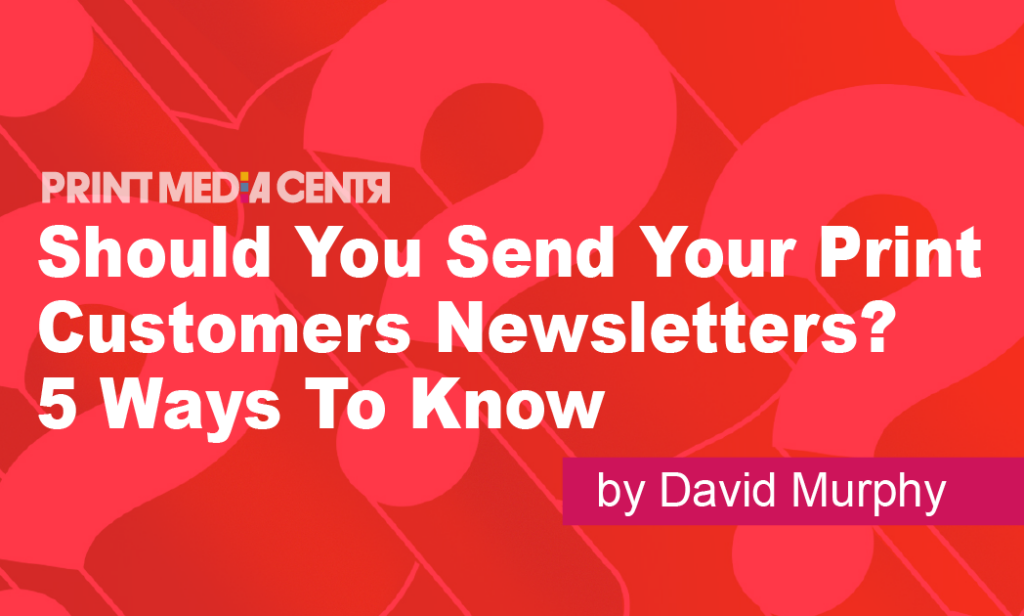
Sending print customers newsletters is an idea that has crossed the mind of every print business owner or marketing manager. “We should start sending out newsletters!” Sounds like a good idea, but is it?
Here are three reasons not to send newsletters:
- Newsletters are expensive. If you are going to mail a printed newsletter, you have the costs of paper, consumables, postage, and equipment operations. Even if you send e-newsletters, there is still the hard cost of email software.
- Newsletter creation takes time and resources. Content research, writing, editing, and graphic design are the obvious expenses but don’t forget opportunity costs. What else could your marketing staff be doing that has higher ROI?
- Does anyone read them? Let’s park that question for a minute.
Wow, that sounds depressing. Why bother? Maybe you should or maybe you shouldn’t.
Let’s look at five questions to ask yourself to help determine the best move forward in sending your print customers a newsletter.
1. Do you have interesting, educational, cool content to share? If you just want to get people to buy from you, then a regular newsletter is probably not the best idea. Mix in some helpful stories, product updates, tips, and tricks, “did you know?” “about us,” and “here’s what’s new” content. Along with that, you can and should absolutely include price specials and product promotions. The key is to blend it together so it’s not just “buy from us” solicitations.
Coming up with fresh new content blurbs can be challenging so it’s a good idea to pace yourself and schedule accordingly. If you don’t think you have enough interesting content to share month after month, then consider a quarterly distribution. Too many print customer newsletter campaigns start off hot (maybe weekly for a month) and then run out of steam and then stop. It’s better to increase the frequency after you can test your readers’ positive engagement than to decrease it after setting a fast pace.
To get ideas for content, read and research other interesting articles in your market or space and determine whether your readers would be interested in your perspective on them. If you decide to just copy others’ content, always get permission and give credit to the original authors.
2. Can your print newsletter serve as an effective sample of your good work? If you have a good graphic designer, an attractive and creative layout and format can show off your capabilities. Consider segmented and personalized content to make your communication more relevant and interesting to each reader. The same goes for a printed newsletter. Experiment with different paper stocks and print methods, embellishments, and formats. Attractive and well-produced newsletters and collateral can inspire your readers to come to you for incremental print work.
3. Can you integrate your newsletter plan into your other marketing messaging? Your newsletter should be an extension of your brand voice, your strengths, and your current marketing priorities. Use relevant content from your website’s product pages and blog posts. Leverage your newsletter content into your social media posts. Consider how you can pool multiple pieces of content together and maybe create an e-book for new prospects. Your newsletter should not operate in a silo. Make it an extension of all the cool stuff you are doing and can do for your readers.
4. Can you maintain a high-quality database? Not just once at the beginning, but continually. A poorly maintained database can cost a lot of money, especially for a printed newsletter. The cost of paper, consumables, labor, and postage can be wasted if your newsletter isn’t delivered to the right person. Even if you just email a soft version of your newsletter, your undeliverable bounces can negatively impact your email domain’s reputation. Too many bounces and unopens and your customers’ email service providers may suppress your messages and increase their placement in spam folders. Whether printed or electronic, make sure you have the resources, bandwidth, and discipline to maintain your database hygiene.
5. Can you test, measure, and analyze your newsletters’ effectiveness? Just sending and sending without study and analysis can be ineffective, costly, and even damaging to your brand. Whenever and however possible using your CRM, Google Analytics, email marketing software, or through personal research, try to determine if people care about your newsletter. Are they actually reading your newsletter, visiting your landing page or product page, and responding to your offers? There are many ways to track your customers’ digital conversions and offline activities. Just find out if your newsletters are contributing to your marketing ROI.
If you can answer Yes to most of these questions, then newsletter communications should probably be included in your communications mix. Try the first one, test it, measure it, and scale it.
##
Read David’s post from last month: https://printmediacentr.com/video-and-more-marketing-strategies-for-your-print-business-part-2
Read all of David’s posts here.
 David Murphy is the founder and CEO of Nvent Marketing, a marketing agency specializing in digital marketing for the print industry. David has 30+ years of experience in the graphics and document print production industry. He has served as a board member and advisor to print organizations and associations including Sustainable Green Printing Partnership (SGP), Print Industries of America (PIA), Association for Print Technologies (APTECH), and Electronic Document Scholarship Foundation (EDSF). David was also awarded the Idealliance Soderstrom Society Award for Print Industry Leadership. David can be reached at [email protected].
David Murphy is the founder and CEO of Nvent Marketing, a marketing agency specializing in digital marketing for the print industry. David has 30+ years of experience in the graphics and document print production industry. He has served as a board member and advisor to print organizations and associations including Sustainable Green Printing Partnership (SGP), Print Industries of America (PIA), Association for Print Technologies (APTECH), and Electronic Document Scholarship Foundation (EDSF). David was also awarded the Idealliance Soderstrom Society Award for Print Industry Leadership. David can be reached at [email protected].












